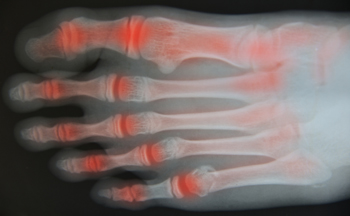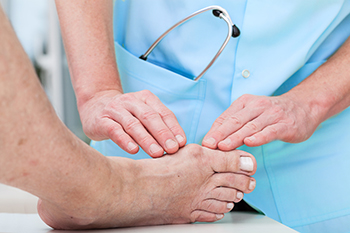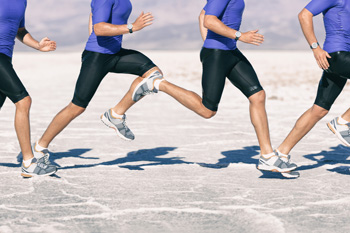Items filtered by date: September 2023
Assistive Devices for Foot or Ankle Arthritis

Assistive devices can be invaluable allies in the daily life of someone living with foot or ankle arthritis. These tools reduce joint stress, making activities more enjoyable and less tiring. For example, grab bars and bath seats can enhance safety and stability in the bathroom. Walking aids like canes should be used properly at the correct height. Podiatrists can recommend suitable assistive devices tailored to specific arthritis needs, helping maintain independence and complete daily activities. These devices are increasingly user-friendly and mainstream, making them accessible to all. If you have foot or ankle arthritis and would like to know more about devices that can make living your life easier, it is suggested that you make an appointment with a podiatrist who is well-versed in this area.
Arthritis can be a difficult condition to live with. If you are seeking treatment, contact Cory Brown, DPM from Cory Brown, DPM. Our doctor can provide the care you need to keep you pain-free and on your feet.
Arthritic Foot Care
Arthritis is a term that is commonly used to describe joint pain. The condition itself can occur to anyone of any age, race, or gender, and there are over 100 types of it. Nevertheless, arthritis is more commonly found in women compared to men, and it is also more prevalent in those who are overweight. The causes of arthritis vary depending on which type of arthritis you have. Osteoarthritis for example, is often caused by injury, while rheumatoid arthritis is caused by a misdirected immune system.
Symptoms
- Swelling
- Pain
- Stiffness
- Decreased Range of Motion
Arthritic symptoms range in severity, and they may come and go. Some symptoms stay the same for several years but could potentially get worse with time. Severe cases of arthritis can prevent its sufferers from performing daily activities and make walking difficult.
Risk Factors
- Occupation – Occupations requiring repetitive knee movements have been linked to osteoarthritis
- Obesity – Excess weight can contribute to osteoarthritis development
- Infection – Microbial agents can infect the joints and trigger arthritis
- Joint Injuries – Damage to joints may lead to osteoarthritis
- Age – Risk increases with age
- Gender –Most types are more common in women
- Genetics – Arthritis can be hereditary
If you suspect your arthritis is affecting your feet, it is crucial that you see a podiatrist immediately. Your doctor will be able to address your specific case and help you decide which treatment method is best for you.
If you have any questions, please feel free to contact our office located in Lewiston, ID . We offer the newest diagnostic and treatment technologies for all your foot care needs.
We Can Treat Your Foot or Ankle Pain
Recovery From Bunion Surgery

Recovering from bunion surgery may take several months but often leads to having pain-free feet. Bunions, bony bumps that develop at the base of the big toe, can cause considerable discomfort and limit your mobility. Surgery is often recommended when conservative treatments, such as orthotics and changes in footwear, are no longer able to provide relief. Immediately after the bunion surgery procedure, you can expect some discomfort and swelling. Your podiatrist may prescribe some type of pain medication to manage this and recommend keeping the foot elevated during the first few days post-surgery to reduce swelling. For the first few weeks, keeping weight off the operated foot is extremely important. A special surgical shoe or boot may be provided to protect your foot from injury, as well as minimize stress on the surgical site. Gradually, supportive footwear may be advised by your podiatrist, along with custom orthotics if needed. Patience is key during the recovery process from bunion surgery. It’s important to avoid high-impact activities, follow up with your podiatrist for monitoring, and adhere to their instructions. With dedication to your recovery plan, you'll increase the likelihood of enjoying pain-free, comfortable feet once again.
If you are suffering from bunions, contact Cory Brown, DPM of Cory Brown, DPM. Our doctor can provide the care you need to keep you pain-free and on your feet.
What Is a Bunion?
A bunion is formed of swollen tissue or an enlargement of boney growth, usually located at the base joint of the toe that connects to the foot. The swelling occurs due to the bones in the big toe shifting inward, which impacts the other toes of the foot. This causes the area around the base of the big toe to become inflamed and painful.
Why Do Bunions Form?
Genetics – Susceptibility to bunions are often hereditary
Stress on the feet – Poorly fitted and uncomfortable footwear that places stress on feet, such as heels, can worsen existing bunions
How Are Bunions Diagnosed?
Doctors often perform two tests – blood tests and x-rays – when trying to diagnose bunions, especially in the early stages of development. Blood tests help determine if the foot pain is being caused by something else, such as arthritis, while x-rays provide a clear picture of your bone structure to your doctor.
How Are Bunions Treated?
- Refrain from wearing heels or similar shoes that cause discomfort
- Select wider shoes that can provide more comfort and reduce pain
- Anti-inflammatory and pain management drugs
- Orthotics or foot inserts
- Surgery
If you have any questions, please feel free to contact our office located in Lewiston, ID . We offer the newest diagnostic and treatment technologies for all your foot care needs.
The Effects of Shoes on Biomechanics of the Feet

Understanding how your choice of footwear can affect your feet, legs, and joints is crucial. Ill-fitting or unsupportive shoes can exert pressure on these areas during physical activity, potentially resulting in discomfort and injuries. Inappropriate footwear choices may contribute to common sports injuries such as shin splints and Achilles tendon pain, as well as foot problems that can include corns, bunions, ingrown nails. These issues can severely limit or even halt your physical activity. Different activities require specific types of footwear, such as beach and road running. Wearing unsuitable shoes can worsen existing problems, such as hip, knee, ankle, or foot pain or arthritis. Even short periods of wearing in ill-fitting shoes can cause stress and pain in your bones, joints, and supporting soft tissues, especially if you stand for extended periods at a time. Your choice of shoes can significantly affect your walking style or gait. The correct step involves the heel making initial contact with the ground, followed by a slight inward roll of the arch. This can allow the ball of the foot and big toe to follow. The heel then lifts off the ground, enabling you to push off from the ball of your foot and big toe. Some individuals have arches that roll excessively inward or outward, both of which can impact how effectively your feet absorb shock. If you have questions about how the shoes you wear are affecting the biomechanics of your feet, it is suggested that you make an appointment with a podiatrist for a consultation.
If you have any concerns about your feet, contact Cory Brown, DPM from Cory Brown, DPM. Our doctor can provide the care you need to keep you pain-free and on your feet.
Biomechanics in Podiatry
Podiatric biomechanics is a particular sector of specialty podiatry with licensed practitioners who are trained to diagnose and treat conditions affecting the foot, ankle and lower leg. Biomechanics deals with the forces that act against the body, causing an interference with the biological structures. It focuses on the movement of the ankle, the foot and the forces that interact with them.
A History of Biomechanics
- Biomechanics dates back to the BC era in Egypt where evidence of professional foot care has been recorded.
- In 1974, biomechanics gained a higher profile from the studies of Merton Root, who claimed that by changing or controlling the forces between the ankle and the foot, corrections or conditions could be implemented to gain strength and coordination in the area.
Modern technological improvements are based on past theories and therapeutic processes that provide a better understanding of podiatric concepts for biomechanics. Computers can provide accurate information about the forces and patterns of the feet and lower legs.
Understanding biomechanics of the feet can help improve and eliminate pain, stopping further stress to the foot.
If you have any questions please feel free to contact our office located in Lewiston, ID . We offer the newest diagnostic and treatment technologies for all your foot and ankle needs.
How to Break in Orthotics

Custom foot orthotics are designed to meet unique structural and biomechanical needs, but they often require a break-in period. This means getting used to them gradually. The adjustment period varies for each person as your body has adapted to moving a certain way over the years. When you first wear them, custom orthotics might feel unusual, like standing on a hard ball with pressure on your arches. Some may feel great right away, like walking on clouds. However, it is crucial to break them in properly. Some tips to get used to orthotics include starting off slowly and wearing them for a few hours at first and then increasing wear time by one or two hours daily over a week. Other tips include reducing wear time if you experience discomfort, wearing them in shoes with the appropriate width and depth, and waiting until they are entirely broken in before engaging in physical activity. Adjustments can possibly be made if discomfort persists. If you are interested in learning more about whether you are a good candidate for orthotics and how to adjust to them, it is suggested that you make an appointment with a podiatrist to discuss this option.
If you are having discomfort in your feet and would like to try orthotics, contact Cory Brown, DPM from Cory Brown, DPM. Our doctor can provide the care you need to keep you pain-free and on your feet.
What Are Orthotics?
Orthotics are inserts you can place into your shoes to help with a variety of foot problems such as flat feet or foot pain. Orthotics provide relief and comfort for minor foot and heel pain but can’t correct serious biomechanical problems in your feet.
Over-the-Counter Inserts
Orthotics come in a wide variety of over-the-counter inserts that are used to treat foot pain, heel pain, and minor problems. For example, arch supports can be inserted into your shoes to help correct overarched or flat feet, while gel insoles are often used because they provide comfort and relief from foot and heel pain by alleviating pressure.
Prescription Orthotics
If over-the-counter inserts don’t work for you or if you have a more severe foot concern, it is possible to have your podiatrist prescribe custom orthotics. These high-quality inserts are designed to treat problems such as abnormal motion, plantar fasciitis, and severe forms of heel pain. They can even be used to help patients suffering from diabetes by treating foot ulcers and painful calluses and are usually molded to your feet individually, which allows them to provide full support and comfort.
If you are experiencing minor to severe foot or heel pain, it’s recommended to speak with your podiatrist about the possibilities of using orthotics. A podiatrist can determine which type of orthotic is right for you and allow you to take the first steps towards being pain-free.
If you have any questions please contact our office located in Lewiston, ID . We offer the newest diagnostic and treatment technologies for all your foot and ankle needs.

